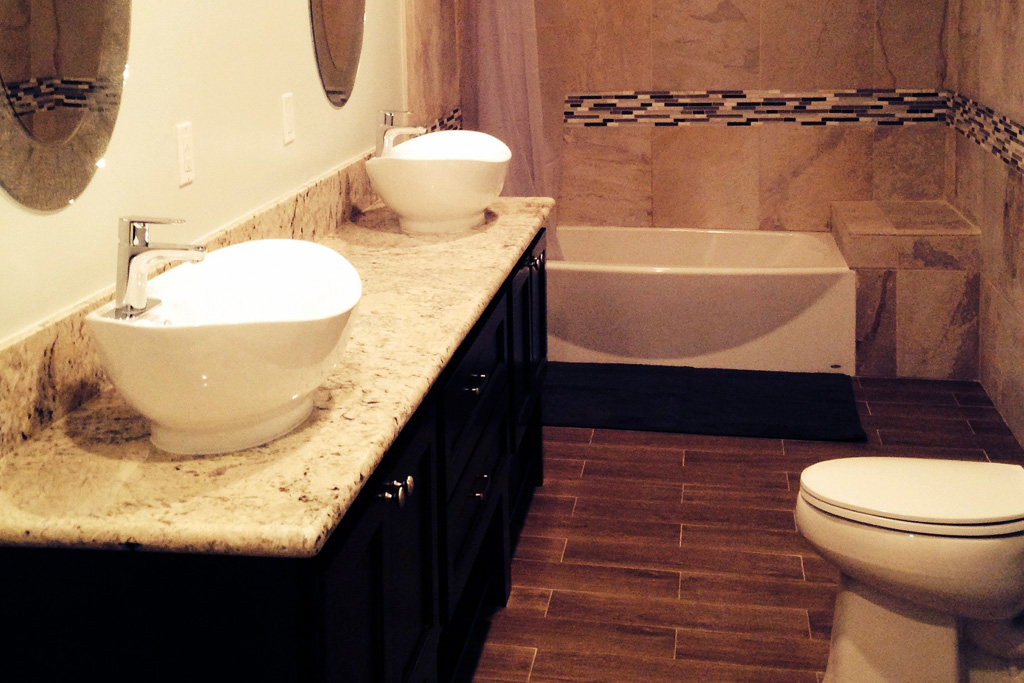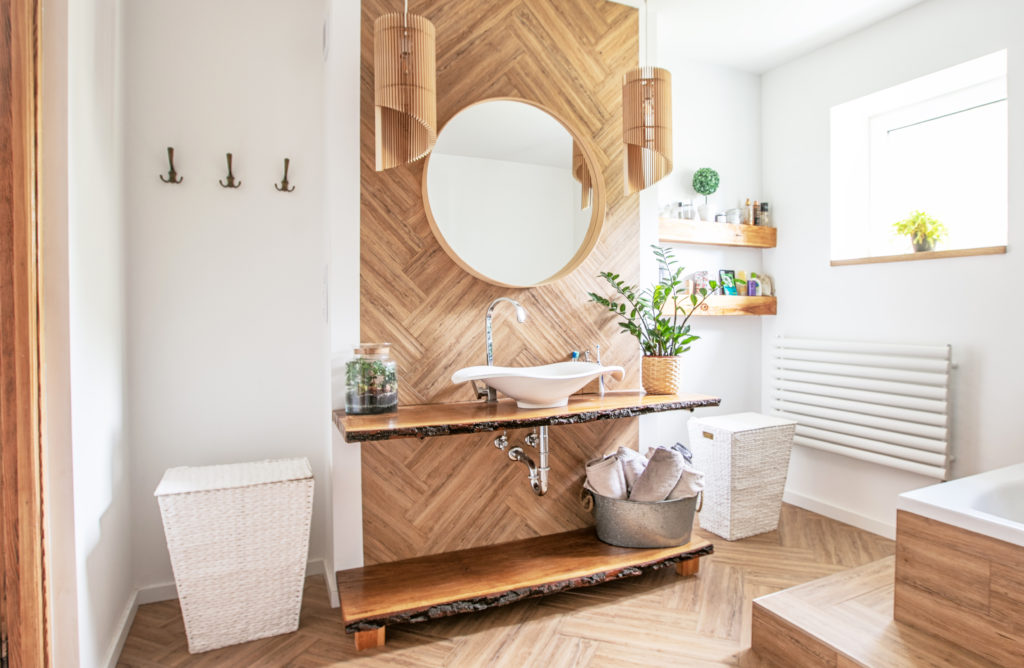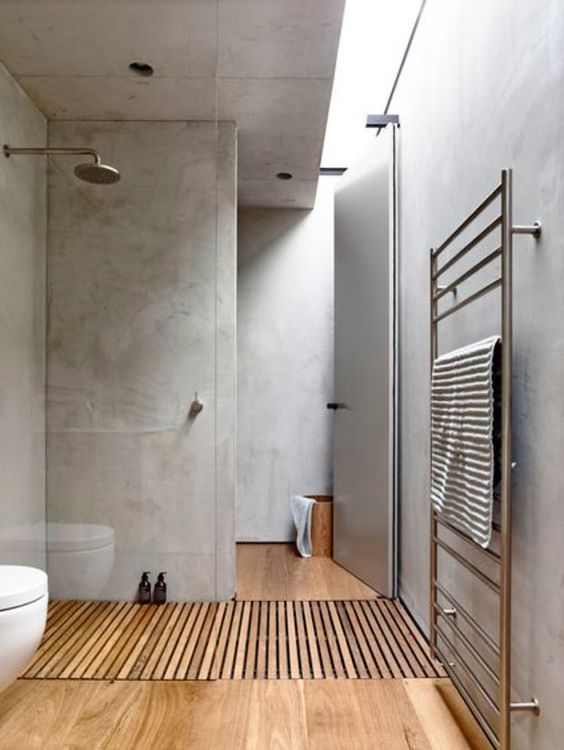The Benefits of Bamboo Flooring in Bathrooms
Let’s start this article by discussing the many benefits of bamboo flooring in bathrooms.
- Eco-Friendly and Sustainable: Bamboo flooring is a popular choice for eco-conscious homeowners due to its sustainability. Bamboo is a fast-growing grass that regenerates quickly, making it an environmentally friendly flooring option. By choosing bamboo flooring for your bathroom, you can contribute to the preservation of forests and reduce your carbon footprint.
- Durability and Water Resistance: One of the key advantages of bamboo flooring in bathrooms is its durability and water resistance. Bamboo is naturally resistant to moisture, making it an excellent choice for wet areas like bathrooms. With proper sealing and maintenance, bamboo flooring can withstand the moisture and humidity commonly found in bathrooms without warping or swelling.
- Aesthetic Appeal: Bamboo flooring offers a unique and natural aesthetic that can elevate the overall look of your bathroom. With various colors and patterns available, you can find bamboo flooring that matches your style and complements your bathroom decor. Whether you prefer a modern, rustic, or traditional look, bamboo flooring can add a touch of elegance and warmth to your bathroom.
- Easy Maintenance: Bamboo flooring is relatively easy to maintain, making it a practical choice for busy homeowners. Regular sweeping or vacuuming and occasional mopping with a damp cloth are usually sufficient to keep bamboo flooring clean. Additionally, bamboo flooring is resistant to stains and scratches, making it an ideal option for high-traffic areas like bathrooms.
- Allergy-Friendly: Unlike carpets, bamboo flooring does not trap dust, pollen, or other allergens, making it a great choice for individuals with allergies or respiratory conditions. Bamboo flooring promotes better indoor air quality, ensuring a healthier environment in your bathroom.

Choosing the Right Bamboo Flooring for Your Bathroom
Now, let’s talk about what factors to consider when choosing bamboo for your bathroom flooring.
- Consider the Grade: When selecting bamboo flooring for your bathroom, consider the grade of the bamboo. Higher-grade bamboo has fewer imperfections and a more uniform color, providing a sleeker and more refined look. Lower-grade bamboo may have more knots and color variations, which can add character to your bathroom floor.
- Look for Moisture Resistance: Opt for bamboo flooring that is specifically designed for high-moisture areas like bathrooms. Look for flooring labeled as “water-resistant” or “moisture-resistant” to ensure its durability in wet conditions.
- Choose the Right Finish: Bamboo flooring comes in various finishes, including matte, semi-gloss, and high-gloss. Consider the level of shine and the overall aesthetic you want to achieve in your bathroom when selecting the finish. Matte finishes can help hide scratches and scuffs, while high-gloss finishes can create a more polished and reflective look.
- Evaluate the Warranty: Before purchasing bamboo flooring, check the warranty offered by the manufacturer. A longer warranty period indicates the manufacturer’s confidence in the product’s quality and durability. Look for warranties that cover moisture-related issues specifically, as this will ensure your flooring is protected in the bathroom environment.
- Seek Professional Guidance: If you are unsure about which bamboo flooring to choose for your bathroom, consult with flooring professionals or interior designers. They can provide expert advice based on your specific needs and budget, helping you make an informed decision.
Installation Tips for Bamboo Flooring in Wet Areas
Acclimate the Flooring: Before installation, allow the bamboo flooring to acclimate to the bathroom’s humidity and temperature. This step helps prevent warping or buckling of the flooring after installation. Follow the manufacturer’s instructions regarding acclimation time, typically 48 to 72 hours.
Ensure Proper Subfloor Preparation: The subfloor in your bathroom should be clean, dry, and level before installing bamboo flooring. Remove any existing flooring and check for any moisture issues or unevenness. Address any subfloor problems before proceeding with the installation.
Use Moisture Barriers: To further protect your bamboo flooring from moisture, consider using a moisture barrier during installation. This can be in the form of a plastic sheet or an underlayment specifically designed for moisture protection. Moisture barriers help prevent water vapor from seeping into the bamboo flooring, increasing its longevity.
Follow the Manufacturer’s Guidelines: Each bamboo flooring manufacturer may have specific installation instructions. Follow these guidelines meticulously to ensure a proper and successful installation. Improper installation can void warranties and lead to issues with the flooring down the line.
Allow Sufficient Expansion Gaps: Bamboo flooring expands and contracts with changes in temperature and humidity. Leave sufficient expansion gaps around the perimeter of the bathroom to accommodate these natural movements. Use spacers during installation to maintain the correct gap width.
Seal the Flooring: After installation, seal the bamboo flooring with a waterproof sealant or finish. This step adds an extra layer of protection against moisture and helps maintain the water resistance of the flooring. Follow the manufacturer’s instructions for sealing and resealing the bamboo flooring as needed.
Maintaining and Cleaning Tips
Regular Sweeping or Vacuuming: To keep your bamboo flooring in the bathroom clean, regularly sweep or vacuum to remove dirt, dust, and debris. Use a soft-bristle broom or a vacuum cleaner with a hardwood floor attachment to prevent scratching the surface.
Avoid Excessive Water: Although bamboo flooring is water-resistant, excessive water can still damage the flooring over time. When mopping, use a damp cloth or mop rather than soaking the floor. Immediately wipe up any spills or splashes to prevent water from seeping into the bamboo.
Use Gentle Cleaning Solutions: When cleaning bamboo flooring, opt for gentle cleaning solutions specifically formulated for hardwood or bamboo floors. Harsh chemicals and abrasive cleaners can damage the finish and degrade the flooring’s water resistance. Follow the manufacturer’s instructions for recommended cleaning products.
Prevent Scratches: Place mats or rugs near bathroom entrances and sinks to catch dirt and prevent scratches from shoes or heavy objects. Felt pads can be applied to the bottom of furniture legs to prevent scratching when moving them.
Avoid Excessive Sunlight Exposure: Prolonged exposure to direct sunlight can cause discoloration and fading of bamboo flooring. Use curtains, blinds, or window tinting to protect the flooring from excessive UV rays.
Regular Maintenance: Periodically inspect the bamboo flooring for any signs of wear, scratches, or water damage. Address any issues promptly to prevent further damage. Follow the manufacturer’s recommendations for refinishing or resealing the flooring as needed to maintain its water resistance.
Exploring Alternative Flooring Options for Your Bathroom
Porcelain or Ceramic Tiles: Tiles are a popular and versatile choice for bathroom flooring. Porcelain or ceramic tiles are highly durable, and water-resistant, and come in a wide range of styles, colors, and patterns. They are also easy to clean and maintain.
Vinyl Flooring: Vinyl flooring is another excellent option for bathrooms due to its water resistance and affordability. It comes in various designs, including those that mimic the look of hardwood or stone. Vinyl flooring is easy to install and can withstand the moisture and humidity of bathrooms.
Natural Stone: Natural stone, such as marble, granite, or limestone, can add a luxurious and elegant touch to your bathroom. These materials are durable and water-resistant when properly sealed. However, they may require more maintenance and care compared to other flooring options.
Engineered Wood: If you desire the look of hardwood but are concerned about its vulnerability to moisture, consider engineered wood flooring. Engineered wood consists of a layer of real wood on top of a plywood or high-density fiberboard (HDF) core, making it more resistant to water damage than solid wood.
Laminate Flooring: Laminate flooring offers the appearance of hardwood or stone at a more affordable price point. It is highly resistant to moisture and easy to clean, making it suitable for bathrooms. However, be cautious with standing water, as it can seep into the seams and cause damage.
Rubber Flooring: Rubber flooring is a durable and slip-resistant option for bathrooms. It provides excellent traction, making it a safe choice for wet areas. Rubber flooring is also easy to clean and maintain.
Related Posts:
- Beach House Bamboo Flooring
- How Much Does Bamboo Flooring Cost Per Square Foot
- Bamboo Flooring And Formaldehyde
- Cheap Bamboo Flooring Melbourne
- Can You Install Bamboo Flooring Over Tile
- Bamboo Flooring Raleigh
- Best Place To Buy Bamboo Flooring
- Bamboo Flooring Formaldehyde Emissions
- How To Replace Bamboo Flooring Planks
- How To Install Morning Star Bamboo Flooring



